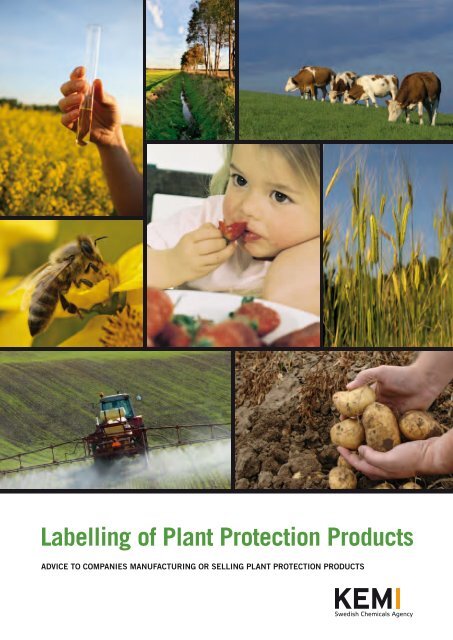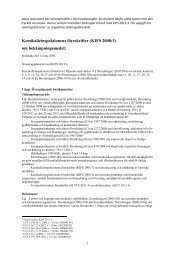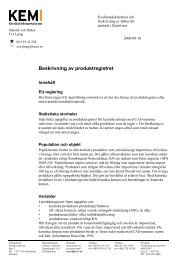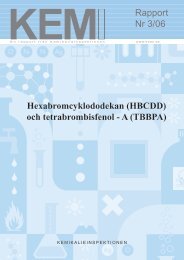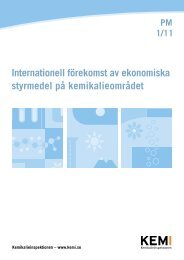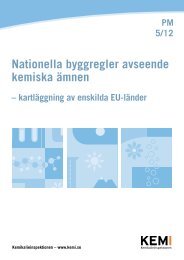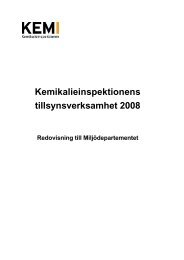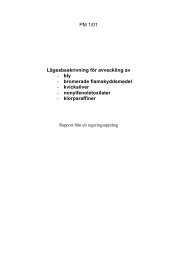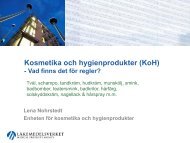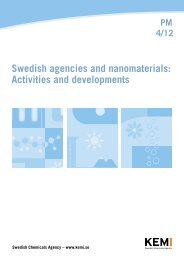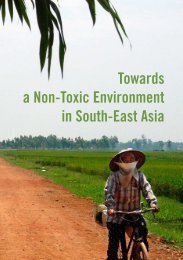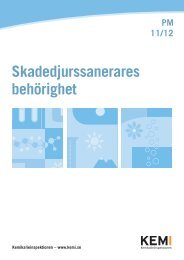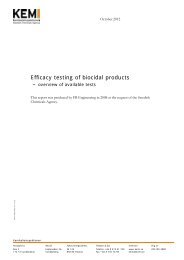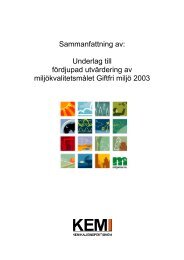Labelling of Plant Protection Products
Labelling of Plant Protection Products
Labelling of Plant Protection Products
Create successful ePaper yourself
Turn your PDF publications into a flip-book with our unique Google optimized e-Paper software.
<strong>Labelling</strong> <strong>of</strong> <strong>Plant</strong> <strong>Protection</strong> <strong>Products</strong><br />
ADVICE TO COMPANIES MANUFACTURING OR SELLING PLANT PROTECTION PRODUCTS<br />
20
<strong>Labelling</strong><br />
<strong>of</strong> <strong>Plant</strong> <strong>Protection</strong> <strong>Products</strong><br />
ADVICE TO COMPANIES<br />
MANUFACTURING OR SELLING<br />
PLANT PROTECTION PRODUCTS<br />
1
Publisher: Swedish Chemicals Agency©<br />
Order No: 510 955<br />
Order address: Telefax +46 8 50 59 33 99<br />
Phone: +46 8 50 59 33 00, e-mail kemi@cm.se<br />
Pictures: page 10: Eva Orsmark,<br />
page 13: Jens Tønnesen/Dansk Landbruks Medier,<br />
other pages: Ina Agency<br />
Layout: Ingse & Co ab<br />
Print: CM Gruppen, Stockholm 2009<br />
2
Contents<br />
Foreword 5<br />
<strong>Plant</strong> protection products 6<br />
How are humans affected 6<br />
How is environment affected 7<br />
eu rules to reduce risks 7<br />
What can companies do 7<br />
Designing a label 9<br />
Designing directions for use 12<br />
Further information 19<br />
STOB<br />
Fungicide<br />
STOB<br />
company CO<br />
FUNGICIDE<br />
company CO<br />
Product Facts<br />
Product action:<br />
Fungicide<br />
registration number: 1234<br />
authorisation class: 1L<br />
Formulation:<br />
Suspension concentrate (SC)<br />
active substance: 200 g/l (20 weight-% stobstrobin<br />
Pack:<br />
1 litre<br />
conditions oF use<br />
Special conditions must be observed in the use <strong>of</strong> plant protection<br />
products. The conditions are stated in the Swedish Chemical Agency’s<br />
authorisation <strong>of</strong> the product and are based on the risks posed by the<br />
product to health and the environment and good agricultural practice.<br />
Crop Pest Permitted treatment Dose<br />
Time Waiting Max Interval<br />
max<br />
dev. stage period number number<br />
l/ha<br />
days treat. days<br />
Winter<br />
wheat<br />
Spring<br />
wheat<br />
Winter<br />
barley<br />
Spring<br />
barley<br />
Application<br />
method<br />
Fungal DC 30–60 – 2 21–30 1,0 Boom sprayer<br />
Fungal DC 30–60 – 2 21–30 1,0 Boom sprayer<br />
Fungal DC 30–60 – 2 21–30 1,0 Boom sprayer<br />
Fungal DC 30–60 – 2 21–30 1,0 Boom sprayer<br />
Oats Fungal DC 33–61 – 1 – 0,5 Boom sprayer<br />
Triticale Fungal DC 32–61 – 2 21–30 1,0 Boom sprayer<br />
Rye Fungal DC 32–61 – 1 – 0,5 Boom sprayer<br />
Field<br />
beans<br />
Fungal DC 51–65 14*/35* 1 – 0,5 Boom sprayer<br />
* Treatment must not take place less than 14 days prior to harvesting <strong>of</strong> fresh beans with pods, 35 days<br />
prior to harvesting <strong>of</strong> dried beans.<br />
Other conditions<br />
• To limit the risks to aquatic organisms, the instructions contained in<br />
General Advice 97:3 and the assistant for determining wind-adapted<br />
safety distance relating to the Swedish Environmental <strong>Protection</strong><br />
Agency Regulations on the Application <strong>of</strong> Chemical Pesticides<br />
(snfs 1997:2) must be observed.<br />
Reg. No 1234. Authorisation class 1L. For pr<strong>of</strong>essional use only with a special licence.<br />
Approved for control <strong>of</strong> fungal disease in the following crops:<br />
• Winter wheat, spring wheat, winter barley, spring barley, oats, triticale and rye.<br />
• Field beans.<br />
No other use is permitted without a special licence.<br />
Read accompanying instructions before use.<br />
Risk information<br />
Harmful by inhalation. Very toxic to aquatic organisms,<br />
may cause long-term adverse effects in the aquatic environment.<br />
Safety instructions<br />
Keep locked up and out <strong>of</strong> the reach <strong>of</strong> children. Use appropriate container to avoid<br />
environmental contamination. Do not breathe fumes/vapour.<br />
In case <strong>of</strong> insufficient ventilation, wear suitable respiratory equipment.<br />
Wear suitable protective clothing and gloves.<br />
Do not contaminate water with the product or its container.<br />
Do not clean application equipment near surface water.<br />
To avoid the build up resistance do not apply this or any products<br />
containing Qo1 fungicides more than twice per season.<br />
First aid<br />
If swallowed, seek medical advice immediately and show this container or label.<br />
For further information, see safety data sheet.<br />
To avoid risks to humans and the environment, follow the directions for use.<br />
Contents: The product is a suspension concentrate (SC) containing 200 g/l (20 weight-%) stobstrobin.<br />
Batch number: 123 456<br />
Empty packaging: Empty container must not be re-used. Treat this material and its container<br />
as hazardous waste.<br />
Manufacturer/authorisation holder:<br />
Company Co<br />
Box 1, 123 45 TOWN, Phone.: 01-20 30 40<br />
Harmful to health<br />
Harmful to<br />
environment<br />
1 litre<br />
3
Foreword<br />
Sustainable production in agriculture is important in making<br />
it possible to protect the surrounding environment. <strong>Plant</strong><br />
protection products are used in agriculture to prevent pest<br />
organisms and competing plants from causing yield and<br />
quality losses. However, hazardous chemical substances in the<br />
plant protection products may pose risks to humans and the<br />
environment. Rules are therefore required to reduce the risks,<br />
for example by preventing incorrect use.<br />
Companies which manufacture or sell plant protection<br />
products have responsibility for passing on knowledge on<br />
appropriate handling to farmers and other users.<br />
This brochure provides advice on how to design clear and<br />
easy-to-read labels and directions for use. It is aimed at companies<br />
which manufacture or sell or import plant protection products into<br />
Sweden from another country outside the eu or the eea 1 and which<br />
are consequently responsible for the labelling <strong>of</strong> plant<br />
protection products.<br />
1. European Economic Area (eea)<br />
5
<strong>Plant</strong> protection products<br />
In order to protect human health and the environment there are rules<br />
stating that plant protection products must be authorised by the Swedish<br />
Chemicals Agency (KemI) before they may be sold or used. KemI<br />
assesses what risks to health and the environment use <strong>of</strong> the plant<br />
protection product may entail and whether the product is sufficiently<br />
effective.<br />
Even an authorised plant protection product may pose risks to health<br />
and the environment. To reduce the risks there are conditions <strong>of</strong> use,<br />
that is to say special rules to be followed by those who use the<br />
products. The conditions relate for instance to authorisation classes,<br />
exposure risks for the user, residue levels in foods, impacts on birds,<br />
mammals and aquatic organisms and leaching to groundwater and<br />
surface water. The provisions are contained in the <strong>Plant</strong> <strong>Protection</strong><br />
<strong>Products</strong> Ordinance 2 .<br />
How are humans affected<br />
<strong>Plant</strong> protection products contain chemical substances which may be<br />
harmful to human health. The risks depend among other things on the<br />
toxic properties <strong>of</strong> the substances and how people are exposed to them.<br />
People may be exposed to plant protection products, for example through<br />
spillages and splashes on the skin, inhalation <strong>of</strong> spray liquid or accidental<br />
ingestion. Some plant protection products may only be used<br />
pr<strong>of</strong>essionally by persons who hold permits and have received training.<br />
When the hazardousness <strong>of</strong> chemical substances is discussed,<br />
a distinction is made between acutely hazardous and chronically hazardous<br />
substances. The latter are substances that cause harm in long-term<br />
exposure. Examples <strong>of</strong> chronically hazardous substances are those that<br />
can cause cancer, affect the genetic material or interfere with<br />
reproduction. Chemical substances may also cause corrosion, skin<br />
irritation and allergies.<br />
<strong>Plant</strong> protection product residues may occur in food products. To<br />
limit the risks there are rules for residue limits. The National Food<br />
Administration is the authority that tests residue limits in foods.<br />
2. Ordinance (2006:1010) on <strong>Plant</strong> <strong>Protection</strong> <strong>Products</strong>.<br />
6
How is the environment affected<br />
Several <strong>of</strong> the substances used in plant protection products are hazardous<br />
to the environment. This means that they may be difficult to break down<br />
(persistent), accumulate in living organisms or be directly toxic, for<br />
example to aquatic organisms. Persistent substances accumulate in the soil<br />
over several years and in the longer term may have an impact on water<br />
quality. <strong>Plant</strong> protection products may enter watercourses or the groundwater<br />
as a result <strong>of</strong> wind drift, evaporation, surface run<strong>of</strong>f or leaching in<br />
the soil. Residues <strong>of</strong> chemical substances are regularly encountered in<br />
surface water and groundwater. The aim is to reduce unnecessary dispersal<br />
to the environment so that residue levels in surface water and groundwater<br />
are as low as possible.<br />
EU rules to reduce risks<br />
The eu works jointly to improve the rules relating to plant protection<br />
products. An important aim is to reduce the quantity <strong>of</strong> hazardous<br />
chemical substances.<br />
Recent developments<br />
• A new plant protection products regulation has been adopted in the eu<br />
which means, among other things, that hazardous substances have to<br />
be replaced by less hazardous ones.<br />
• The eu’s review programme for plant protection products has meant<br />
that substances <strong>of</strong> very high concern may no longer be used.<br />
• A new directive for sustainable use <strong>of</strong> pesticides 3 has been adopted in<br />
the eu.<br />
• A new regulation on the classification, labelling and packaging <strong>of</strong><br />
substances and mixtures 4 has come into force.<br />
What can companies do<br />
Companies manufacturing or selling plant protection products are<br />
responsible, under current rules, for labelling them correctly. The rules on<br />
labelling are wide-ranging, including special requirements regarding how<br />
the information that reaches the user is to be formulated. The particulars<br />
shown on the label and in the associated directions for use must provide<br />
information on what risks use <strong>of</strong> the product poses and how to protect<br />
oneself against unnecessary or harmful exposure. By designing labels and<br />
directions for use in a clear and easy-to-read way, manufacturers and sellers<br />
<strong>of</strong> plant protection products can assist farmers and other users in reducing<br />
the risks in handling.<br />
3. Directive <strong>of</strong> the European Parliament and <strong>of</strong> the Council 2009/128/ec establishing a framework<br />
for Community action to achieve the sustainable use <strong>of</strong> pesticides.<br />
4. Regulation (ec) No 1272/2008 on classification, labelling and packaging <strong>of</strong> substances and mixtures.<br />
7
!<br />
Make<br />
!<br />
Design<br />
!<br />
!<br />
!<br />
Follow<br />
!<br />
Be<br />
Advice<br />
to manufacturers and sellers <strong>of</strong> plant protection products<br />
sure that the particulars are correct on labels and<br />
directions for use.<br />
the labels uniformly so that the farmer and other users<br />
can find important information quickly and easily.<br />
Position the information which is most important at the start <strong>of</strong><br />
the directions for use.<br />
Use a table format for the description <strong>of</strong> conditions <strong>of</strong> use so that<br />
the farmer and other users can follow the rules more easily.<br />
the main headings in the example directions for use<br />
(see page 12) to make sure that the most important information<br />
is included.<br />
clear about the distinction between rules and instructions in<br />
the directions for use.<br />
To illustrate how the above advice can be used, examples are given in the<br />
next section <strong>of</strong> a label and directions for use. The examples represent<br />
templates on which the design <strong>of</strong> the labelling can be based.<br />
8
Designing a label<br />
The labelling <strong>of</strong> plant protection products must comply with the rules<br />
contained in Annex 1 to the Swedish Chemicals Agency’s Pesticides<br />
Regulations (kifs 2008:3) and the Swedish Chemicals Agency’s<br />
Regulations on Classification and <strong>Labelling</strong> <strong>of</strong> Chemical <strong>Products</strong><br />
(kifs 2005:7) or Regulation (ec) No 1272/2008 on Classification, <strong>Labelling</strong><br />
and Packaging <strong>of</strong> Substances and Mixtures. The provisions contain a full<br />
description <strong>of</strong> how the label is to be designed.<br />
Examples <strong>of</strong> details to appear on a label:<br />
q Trade name.<br />
q Name and address <strong>of</strong> the authorisation holder.<br />
q Where applicable, name and address <strong>of</strong> whoever is responsible for<br />
final labelling.<br />
q Registration number.<br />
q Name and concentration <strong>of</strong> each active substance.<br />
q Net quantity.<br />
q Batch number.<br />
q First-aid details.<br />
q Information to the effect that the packaging must not be re-used if the<br />
product has been classified as very toxic, toxic or harmful to health,<br />
unless the container is specially intended for re-use, reloading or<br />
refilling by the manufacturer or distributor.<br />
q Special rules for humans, animals or the environment, for example<br />
“Contact with vapours causes corrosion <strong>of</strong> skin and eyes” or “Contact<br />
with liquid causes frostbite”.<br />
q Special phrases for the protection <strong>of</strong> humans, animals or the<br />
environment, for example “Do not contaminate water with the<br />
product or its container. Do not clean application equipment near<br />
surface water” or “To protect bees and other pollinating insects do<br />
not apply to crop plants when in flower”.<br />
q Function, for example fungicide, insecticide or herbicide.<br />
q Presentation, for example suspension concentrate, granules or spray<br />
powder.<br />
q Approved use followed by the words “No other use is permitted<br />
without special licence”.<br />
q Instructions on use and dosage.<br />
q Details <strong>of</strong> waiting period.<br />
q Details <strong>of</strong> possible phytotoxicity.<br />
q The words “Read accompanying instructions before use”.<br />
q Instructions on final disposal <strong>of</strong> the plant protection product and<br />
packaging.<br />
q Use-by date (if the shelf life is less than two years).<br />
q The words “To avoid risks to humans and the environment, follow<br />
the directions for use”.<br />
9
q User category and the words “For pr<strong>of</strong>essional use only with special<br />
licence” if the plant protection product belongs to authorisation class<br />
1 or the words “Pr<strong>of</strong>essional use only” if the plant protection product<br />
belongs to authorisation class 2.<br />
q Classification and labelling in accordance with kifs 2005:7 or<br />
Regulation (ec) No 1272/2008.<br />
If there is insufficient space on the packaging, some <strong>of</strong> the information<br />
can be supplied on a separate information sheet which accompanies each<br />
pack. For further details, see Annex 1 to kifs 2008:3.<br />
Points to bear in mind in designing a label<br />
• Place the name <strong>of</strong> the plant protection product at a prominent<br />
location on the label.<br />
• The approved use should be placed at the start <strong>of</strong> the label, but<br />
other conditions <strong>of</strong> use may be placed in the directions for use if<br />
there is insufficient space on the label.<br />
• It is advisable to place risk information, safety instructions and<br />
first-aid details in a frame to make the information clearer.<br />
10
Example <strong>of</strong> the appearance <strong>of</strong> a label<br />
STOB<br />
FUNGICIDE<br />
company CO<br />
Reg. No 1234. Authorisation class 1L. For pr<strong>of</strong>essional use only with a special licence.<br />
Approved for control <strong>of</strong> fungal disease in the following crops:<br />
• Winter wheat, spring wheat, winter barley, spring barley, oats, triticale and rye.<br />
• Field beans.<br />
No other use is permitted without a special licence.<br />
Read accompanying instructions before use.<br />
Risk information<br />
Harmful by inhalation. Very toxic to aquatic organisms,<br />
may cause long-term adverse effects in the aquatic environment.<br />
Safety instructions<br />
Keep locked up and out <strong>of</strong> the reach <strong>of</strong> children. Use appropriate container to avoid<br />
environmental contamination. Do not breathe fumes/vapour.<br />
In case <strong>of</strong> insufficient ventilation, wear suitable respiratory equipment.<br />
Wear suitable protective clothing and gloves.<br />
Do not contaminate water with the product or its container.<br />
Do not clean application equipment near surface water.<br />
To avoid the build up resistance do not apply this or any products<br />
containing Qo1 fungicides more than twice per season.<br />
First aid<br />
If swallowed, seek medical advice immediately and show this container or label.<br />
For further information, see safety data sheet.<br />
Harmful to health<br />
Harmful to<br />
environment<br />
To avoid risks to humans and the environment, follow the directions for use.<br />
Contents: The product is a suspension concentrate (SC) containing 200 g/l (20 weight-%) stobstrobin.<br />
Batch number: 123 456<br />
Empty packaging: Empty container must not be re-used. Treat this material and its container<br />
as hazardous waste.<br />
Manufacturer/authorisation holder:<br />
Company Co<br />
Box 1, 123 45 TOWN, Phone.: 01-20 30 40<br />
1 litre<br />
11
Designing directions for use<br />
Directions for use must contain all important information needed for<br />
suitable handling. The directions must be unique to each individual<br />
product. You should therefore avoid giving too much general<br />
information. Suggestions for possible structuring <strong>of</strong> the directions for use<br />
and for what contents are most relevant for the farmer and other users:<br />
q Product facts<br />
Details <strong>of</strong> the effect <strong>of</strong> the plant protection product, registration<br />
number, authorisation class, active substance etc.<br />
q Conditions <strong>of</strong> use<br />
Description <strong>of</strong> the conditions <strong>of</strong> use that follow the authorisation <strong>of</strong><br />
the plant protection product. There are rules which the user is<br />
obliged to follow, which should also be clearly apparent.<br />
q Restrictions<br />
Information on special instructions in connection with use <strong>of</strong> the<br />
plant protection product. Direct or indirect harmful side-effects on<br />
plants or plant products etc. If there are no restrictions, this should<br />
also be apparent.<br />
q Directions for use<br />
The following headings are proposed so that the user understands the<br />
function <strong>of</strong> the product as well as possible:<br />
Mode <strong>of</strong> action<br />
Description <strong>of</strong> how the product’s mode <strong>of</strong> action influences the<br />
objective <strong>of</strong> treatment. For example, preventive or curative effect,<br />
contact action or systemic action.<br />
Risk <strong>of</strong> resistance<br />
Information on whether there is a risk <strong>of</strong> resistance and a strategy for<br />
avoiding this. Whether the resistance is serious can also be apparent<br />
on the label under “Safety instructions”.<br />
Optimum conditions for action<br />
Information on whether the treatment is affected by wind,<br />
precipitation, temperature, air humidity etc. and how the user can<br />
carry out the most effective treatment. State also rainpro<strong>of</strong>ness.<br />
Dose, quantity <strong>of</strong> water and time <strong>of</strong> treatment<br />
Instructions on what dose is to be used, what quantity <strong>of</strong> water it is<br />
appropriate to use and when treatment has to take place with respect<br />
to infection pressure to obtain optimum treatment.<br />
Application technique<br />
Information on what application equipment is needed and<br />
recommended tractor speed, quantity <strong>of</strong> water, pressure, spray<br />
quality and boom height. In cases where there are conditions for use<br />
<strong>of</strong> drift-reduced equipment this can also be made apparent here.<br />
Refer in the directions for use to the brochure “Assistant for use in<br />
determining wind-adapted safety distance in use <strong>of</strong> an agricultural<br />
12
sprayer with boom”. This brochure can be downloaded from<br />
www.greppa.nu.<br />
Protective equipment<br />
Description <strong>of</strong> personal protective equipment in the various<br />
operations such as filling, treatment and cleaning <strong>of</strong> equipment<br />
taking account <strong>of</strong> what type <strong>of</strong> equipment is used, for example<br />
agricultural sprayer or backpack sprayer.<br />
• Respiratory protection (suitable face mask and filter).<br />
• Hand protection (type <strong>of</strong> material).<br />
• Eye protection (goggles or visor).<br />
• Skin protection (apron, protective shoes or protective suit).<br />
Mixtures<br />
Instructions if the product is physically miscible with other plant<br />
protection products.<br />
Preparation <strong>of</strong> spray liquid<br />
Information on how the agricultural sprayer, backpack sprayer etc.<br />
is to be safely filled.<br />
Cleaning <strong>of</strong> application equipment<br />
Instructions on how application equipment is to be safely cleaned.<br />
Empty packaging<br />
Information on management <strong>of</strong> residues and spillages <strong>of</strong> the plant<br />
protection product and empty packaging; state whether the<br />
residual products can be recycled or whether they have to be treated<br />
as hazardous waste. <strong>Plant</strong> protection products labelled with safety<br />
phrases S56 and S60 are hazardous waste and must not be recycled.<br />
Storage<br />
Description <strong>of</strong> what is specific to the product, for example storage<br />
away from frost.<br />
13
Example <strong>of</strong> appearance <strong>of</strong> directions for use<br />
STOB<br />
FUNGICIDE<br />
company CO<br />
PRODUCT FACTS<br />
Product action: Fungicide<br />
Registration number: 1234<br />
Authorisation class: 1L<br />
Formulation: Suspension concentrate (SC)<br />
Active substance: 200 g/l (20 weight-% stobstrobin<br />
Pack: 1 litre<br />
CONDITIONS OF USE<br />
Special conditions must be observed in the use <strong>of</strong> plant protection<br />
products. The conditions are stated in the Swedish Chemical Agency’s<br />
authorisation <strong>of</strong> the product and are based on the risks posed by the<br />
product to health and the environment and good agricultural practice.<br />
Crop Pest Permitted treatment Dose<br />
Time<br />
max<br />
dev. stage<br />
l/ha<br />
Waiting<br />
period<br />
days<br />
Max<br />
number<br />
treat.<br />
Interval<br />
number<br />
days<br />
Application<br />
method<br />
Winter Fungal DC 30–60 – 2 21–30 1,0 Boom sprayer<br />
wheat<br />
Spring Fungal DC 30–60 – 2 21–30 1,0 Boom sprayer<br />
wheat<br />
Winter Fungal DC 30–60 – 2 21–30 1,0 Boom sprayer<br />
barley<br />
Spring Fungal DC 30–60 – 2 21–30 1,0 Boom sprayer<br />
barley<br />
Oats Fungal DC 33–61 – 1 – 0,5 Boom sprayer<br />
Triticale Fungal DC 32–61 – 2 21–30 1,0 Boom sprayer<br />
Rye Fungal DC 32–61 – 1 – 0,5 Boom sprayer<br />
Field Fungal DC 51–65 14*/35* 1 – 0,5 Boom sprayer<br />
beans<br />
* Treatment must not take place less than 14 days prior to harvesting <strong>of</strong> fresh beans with pods, 35 days<br />
prior to harvesting <strong>of</strong> dried beans.<br />
Other conditions<br />
• To limit the risks to aquatic organisms, the instructions contained in<br />
General Advice 97:3 and the assistant for determining wind-adapted<br />
safety distance relating to the Swedish Environmental <strong>Protection</strong><br />
Agency Regulations on the Application <strong>of</strong> Chemical Pesticides<br />
(snfs 1997:2) must be observed.<br />
14
Note that conditions <strong>of</strong> use and other conditions are statutory<br />
requirements and must be complied with by the person using the<br />
product.<br />
Restrictions<br />
Stob, used in the recommended quantity, has not shown any harmful<br />
effects in trials with cereals and can be regarded as safe to use. There are<br />
no restrictions regarding resowing or subsequent crop.<br />
Directions for use<br />
Mode <strong>of</strong> action<br />
Stob acts systemically (it is carried through the sap flows) in the plant but<br />
also has a translaminar (leaf-penetrating) effect. The product is<br />
principally used for preventive purposes. The best effect is achieved in<br />
direct treatment, that is to say when the first attacks become visible on<br />
the plant. After treatment the plant is protected against fungal attack for<br />
4–6 weeks.<br />
Risk <strong>of</strong> resistance<br />
Resistance is shown by poor or inadequate effect <strong>of</strong> treatment. Stob<br />
contains the active substance stobstrobin, which belongs to the group<br />
<strong>of</strong> Qo1 fungicides (strobilurins). Resistance to strobilurins has been<br />
identified in cereals in mildew and leaf blotch attack in wheat.<br />
Avoid resistance by:<br />
• Using Stob together with other fungicides which do not belong to<br />
the Qo1 group.<br />
• Using Stob preventively or as early as possible when signs <strong>of</strong> attack<br />
appear.<br />
• Use a maximum <strong>of</strong> two treatments <strong>of</strong> Stob per year.<br />
Optimum conditions for action<br />
Treatment should take place when the level <strong>of</strong> fungal attack is low and the<br />
crop is growing well. For optimum action, Stob should be used when the<br />
temperature is 15–18 degrees and the air humidity is over 70 per cent. Avoid<br />
treating in extreme weather conditions, for example during a drought or in<br />
high temperatures (
Dose, quantity <strong>of</strong> water and time <strong>of</strong> treatment<br />
Follow the instructions in the table below. Check the effect <strong>of</strong> the<br />
treatment by leaving an untreated area <strong>of</strong> at least 25 square metres in the<br />
field.<br />
Crop Pest Dose l/ha Quantity <strong>of</strong><br />
water l/ha<br />
Wheat leaf blotch<br />
Winter<br />
wheat/<br />
spring<br />
wheat<br />
Leaf spot<br />
Brown spot<br />
Brown rust<br />
Yellow rust<br />
1,0 l/ha or<br />
(2*0,5)<br />
Time<br />
dev. stage<br />
200–300 DC 47–59<br />
DC 47–55<br />
DC 47–55<br />
DC 37–59<br />
DC 30-59<br />
Remarks<br />
If there is heavy infection pressure<br />
two treatments may be needed. If so,<br />
use a dose <strong>of</strong> 0.5 l/ha at an interval<br />
<strong>of</strong> 21-30 days. The first treatment is<br />
done in DC 37-39 and the second in<br />
DC 55-59.<br />
Winter<br />
barley/<br />
spring<br />
barley<br />
Leaf spot<br />
Leaf blotch<br />
Barley brown rust<br />
1,0 l/ha or<br />
(2*0,5)<br />
200–300 DC 37–39<br />
DC 37–39<br />
DC 30–59<br />
In the event <strong>of</strong> early and heavy attacks<br />
it is appropriate to treat twice.<br />
If doing so, use the lower dose <strong>of</strong> 0.5<br />
l/ha at an interval <strong>of</strong> 21-30 days. The<br />
first treatment is done in DC 31-32<br />
and the second in DC 45-47.<br />
Oats Leaf spot<br />
0,5 l/ha 200–300 DC 37–59 Max. 1 treatment<br />
Brown spot<br />
Triticale Leaf spot<br />
Leaf blotch<br />
Wheat leaf blotch<br />
1,0 l/ha or<br />
(2*0,5)<br />
200–300 DC 37–55<br />
DC 37–55<br />
DC 37–55<br />
In the event <strong>of</strong> early and heavy attacks<br />
it is appropriate to treat twice.<br />
If doing so, use the lower dose <strong>of</strong> 0.5<br />
l/ha at an interval <strong>of</strong> 21-30 days. The<br />
first treatment is done in DC 31-32<br />
and the second in DC 45-47.<br />
Rye Leaf blotch<br />
Leaf spot<br />
Field beans Anthracnose<br />
Chocolate spot<br />
0,5 l/ha 200–300 DC 37–49<br />
DC 37–49<br />
0,5 l/ha 200–300 –<br />
Max. one treatment<br />
Application technique<br />
When using Stob it is important that the spray liquid covers all parts <strong>of</strong><br />
the crop. If growth is vigorous a larger quantity <strong>of</strong> liquid should be used<br />
to provide better coverage. A lower tractor speed also results in better<br />
coverage, as well as larger nozzles that provide an increased quantity <strong>of</strong><br />
liquid.<br />
–<br />
A suitable time for control is at onset<br />
<strong>of</strong> flowering. Max. one treatment.<br />
16
Examples <strong>of</strong> spreaders:<br />
Spreader ISO 110–025 (purple) ISO 110–03 (blue)<br />
Tractor speed 7,5 km/h 7,0 km/h<br />
Quantity <strong>of</strong> water 200 litres 300 litres<br />
Pressure 2,6 bar 2,8 bar<br />
Shower quality Medium Medium<br />
Boom height above crop 40–50 cm 40–50 cm<br />
Spraying must take place under conditions which do not lead to wind drift.<br />
Follow the recommendation in the brochure “Assistant for use in<br />
determining wind-adapted safety distance in use <strong>of</strong> an agricultural sprayer<br />
with boom”. The sprayer must be function-tested and correctly calibrated<br />
to obtain best results.<br />
Protective equipment<br />
The following protective equipment must be used when filling and<br />
cleaning the agricultural sprayer:<br />
• Half-mask with particle filter P2.<br />
• Safety gloves (inner glove <strong>of</strong> latex and outer glove <strong>of</strong> nitrile rubber).<br />
• Visor.<br />
• Protective overalls and protective boots.<br />
Follow general hygiene measures by:<br />
• Avoiding contact with skin, eyes and clothes.<br />
• Refraining from eating, drinking, smoking or taking snuff at the<br />
workplace.<br />
• Removing contaminated clothes.<br />
• Keeping protective equipment separate.<br />
• Washing hands before breaks.<br />
• Showering and washing all clothes at the end <strong>of</strong> the shift.<br />
Mixtures<br />
Stob can be mixed with other plant protection products without<br />
chemical precipitations being formed.<br />
Preparation <strong>of</strong> spray liquid<br />
In fulling tank:<br />
17
• Half-fill with water.<br />
• Follow the recommended dose according to the table.<br />
• Pour the measured dose into the half-filled tank.<br />
• Add any other products and the remainder <strong>of</strong> the water while stirring.<br />
The spray liquid must be stirred in transport and during spraying.<br />
When spray liquid is being prepared no liquid must escape into drains,<br />
rivers or water sources. Use a biobed or a slab with collection.<br />
Cleaning <strong>of</strong> application equipment<br />
Clean the spraying equipment both externally and internally.<br />
Start with internal cleaning <strong>of</strong> the sprayer:<br />
1. Empty the sprayer.<br />
2. Then add a third <strong>of</strong> the contents <strong>of</strong> the rinsing water tank and rinse<br />
the sprayer.<br />
3. Spray the used rinsing water out onto the crop.<br />
4. Refill with another third <strong>of</strong> the water.<br />
5. Add suitable cleaning product to the second rinsing.<br />
6. Circulate the product and the water in the system and spread out.<br />
7. Refill with the last third <strong>of</strong> the water.<br />
8. Circulate the liquid in the system and spread out.<br />
Continue with external cleaning <strong>of</strong> sprayer and tractor. Clean spraying<br />
equipment immediately after use to reduce the risk <strong>of</strong> left-over residues<br />
<strong>of</strong> other products. <strong>Products</strong> not intended to be used for certain crops<br />
may cause damage and reduced yields.<br />
Empty packaging<br />
Empty container must not be re-used. Product residues and used<br />
packaging are hazardous waste and must be sent for destruction. Contact<br />
the local authority environmental and health protection department for<br />
information on waste management.<br />
Storage<br />
Store the product in a dry and cool place away from frost in order to<br />
maintain its stability as well as possible.<br />
18
Further information<br />
the swedish chemicals agency is responsible among other things for<br />
the authorisation <strong>of</strong> plant protection products and rules on classification,<br />
labelling and packaging. Read more on the Swedish Chemicals Agency<br />
website: www.kemi.se<br />
the swedish environmental protection agency is responsible among<br />
other things for reducing the impact on the natural<br />
environment <strong>of</strong> the use and application <strong>of</strong> plant protection<br />
products, as well as waste issues.<br />
Read more on the Swedish Environmental <strong>Protection</strong> Agency website:<br />
www.naturvardsverket.se<br />
the swedish board <strong>of</strong> agriculture’s crop protection centres <strong>of</strong>fer<br />
advice on weeds, fungal diseases, pests etc. Read more on the Swedish<br />
Board <strong>of</strong> Agriculture website: www.jordbruksverket.se<br />
the national food administration is responsible for food safety and<br />
among other things checks limits for pesticide levels in foods.<br />
Read more on the National Food Administration website:<br />
www.livsmedelsverket.se<br />
the swedish work environment authority works for the right to healthy,<br />
safe and stimulating working conditions and among other things is<br />
concerned with protective equipment in the use <strong>of</strong> plant protection products.<br />
Read more on the Swedish Work Environment Authority website: www.<br />
arbetsmiljoverket.se<br />
the swedish crop protection association is an industry<br />
organisation which works to ensure safe use <strong>of</strong> plant protection products.<br />
Read more on the Swedish Crop <strong>Protection</strong> Association<br />
website: www.svensktvaxtskydd.se.<br />
greppa växtskyddet (Focus on <strong>Plant</strong> <strong>Protection</strong>) is an<br />
information and training campaign aimed at improving the<br />
management <strong>of</strong> plant protection products in Swedish agriculture.<br />
Read more on the Focus on <strong>Plant</strong> <strong>Protection</strong> website:<br />
www.greppa.nu<br />
19
Esplanaden 3A, Box 2<br />
SE-172 13 Sundbyberg<br />
22<br />
www.kemi.se


